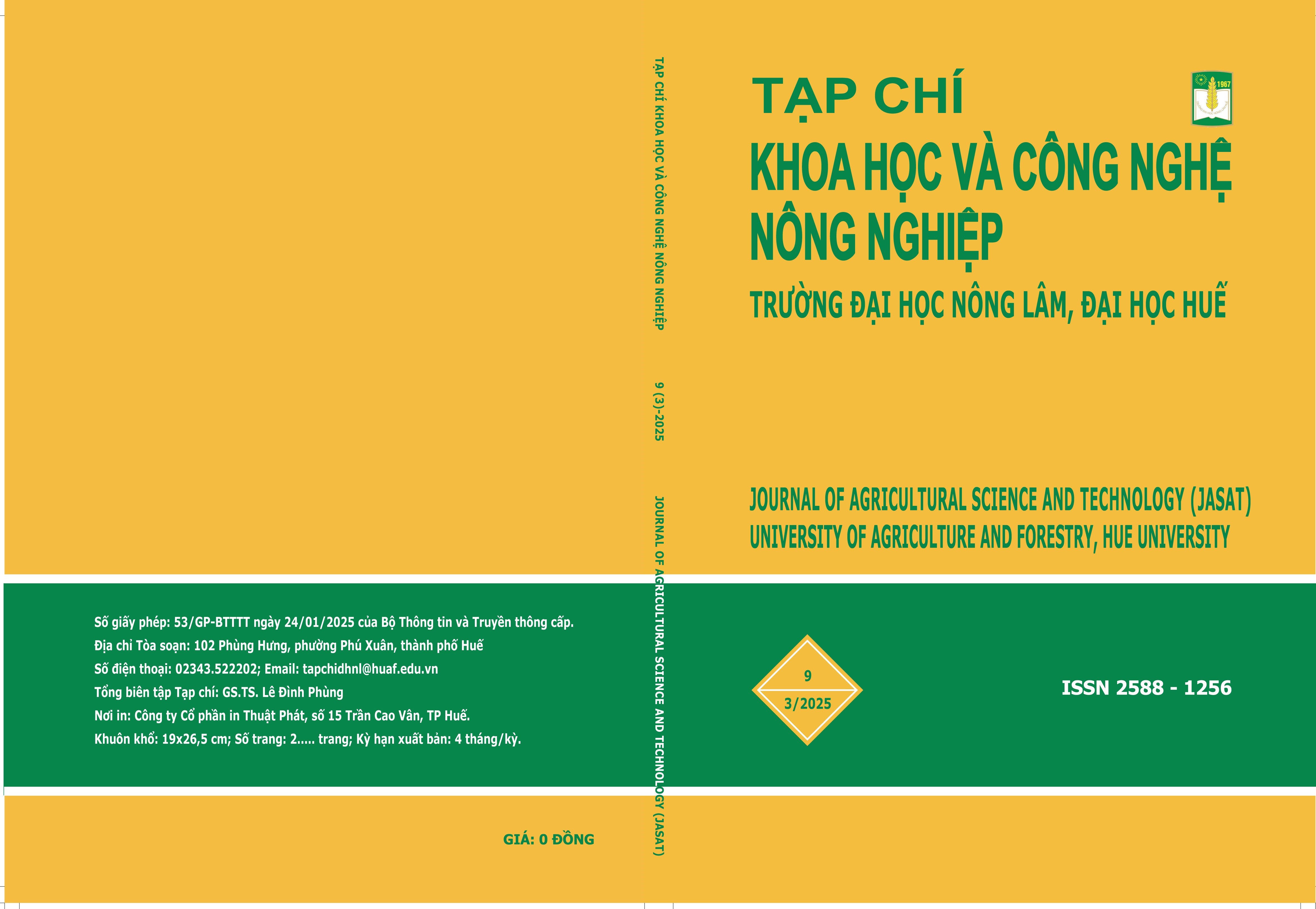##plugins.themes.huaf_theme.article.main##
Abstract
This study was conducted to identify P. oryzae causing rice blast disease in An Giang province, and to evaluate the effectiveness of silver nanoparticles on a silica-based matrix (Ag/SiO₂) on isolated strains. P. oryzae was isolated from diseased samples using the single-spore isolation method and was identified based on morphological characteristics and the sequence of the ITS gene region. Five P. oryzae isolates involving TS1A, TS2B, TT1C, TT2A, and TC1B exhibited grayish-white mycelia growing close to the agar surface, forming concentric rings with dark brown melanin pigmentation. The conidia were two-septate, slender, slightly pointed at both ends, and symmetrically aligned along the longitudinal axis. Based on ITS gene sequencing, isolate TS1A was confirmed as P. oryzae. The nanomaterials Ag/SiO2-CMC and Ag/SiO2-CTS completely inhibited the mycelial growth of P. oryzae TS1A at concentrations of 60 and 75 ppm, respectively, while Ag/SiO2-TWE inhibited 78.4% of the mycelial growth of P. oryzae TS1A at 90 ppm. The Ag/SiO2 nanomaterials altered the typical hyphal structure, causing breakage or rupture. This research highlighted the strong potential of the Ag/SiO2 nanomaterials for developing a product for managing rice blast disease in rice cultivation.
##plugins.themes.huaf_theme.article.details##
References
Balouiri, M., Sadiki, M., Ibnsouda, S.K. (2016). Methods for in vitro evaluating antimicrobial activity: A review. Journal of Pharmaceutical Analysis 6, 71–79. DOI: 10.1016/j.jpha.2015.11.005.
Bui, T.T.T., Tran, Q.V., Vo, T.N.H., Do, H.K., Hoang, D., Duy, L.T., Nguyen, T.T., Dang, V.Q., Tran, C.K. (2024). Surface properties-dependent antifungal efficiency of Ag/SiO2 nanocomposites. Journal of Nanoparticle Research 26, 273, 14 pp. DOI: 10.1007/s11051-024-06190-1.
D’Ávila, L.S., De Filippi, M.C.C., Café-Filho, A.C. (2021). Sensitivity of Pyricularia oryzae Populations to Fungicides Over a 26-Year Time Frame in Brazil. Plant Disease 105, 1771–1780. DOI: 10.1094/PDIS-08-20-1806-RE.
Groth, D.E. (2006). Azoxystrobin Rate and Timing Effects on Rice Head Blast Incidence and Rice Grain and Milling Yields. Plant Disease 90, 1055–1058. DOI: 10.1094/PD-90-1055.
Karunakaran, G., Suriyaprabha, R., Manivasakan, P., Yuvakkumar, R., Rajendran, V., Prabu, P., Kannan, N. (2013). Effect of nanosilica and silicon sources on plant growth promoting rhizobacteria, soil nutrients and maize seed germination. IET Nanobiotechnology 7, 70–77. DOI: 10.1049/iet-nbt.2012.0048.
Khan, F., Pandey, P., Upadhyay, T.K. (2022). Applications of Nanotechnology-Based Agrochemicals in Food Security and Sustainable Agriculture: An Overview. Agriculture 12, 1672. DOI : 10.3390/agriculture12101672.
Longya, A., Talumphai, S., Jantasuriyarat, C. (2020). Morphological Characterization and Genetic Diversity of Rice Blast Fungus, Pyricularia oryzae, from Thailand Using ISSR and SRAP Markers. Journal of Fungi 6(1), 38, 13 pp. DOI: 10.3390/jof6010038.
Mew, T.-W., Gonzales, P. (2002). A handbook of rice seedborne fungi. International Rice Research Institute, 83 pp.
Mollahosseini, A., Rahimpour, A., Jahamshahi, M., Peyravi, M., Maryam, K. (2012). The effect of silver nanoparticle size on performance and antibacteriality of polysulfone ultrafiltration membrane. Desalination, 306, 41–50. DOI: 10.1016/j.desal.2012.08.035.
Montaser, A.S., Jlassi, K., Ramadan, M.A., Sleem, A.A., Attia, M.F. (2021). Alginate, gelatin, and carboxymethyl cellulose coated nonwoven fabrics containing antimicrobial AgNPs for skin wound healing in rats. International Journal of Biological Macromolecules, 173, 203–210. DOI: 10.1016/j.ijbiomac.2021.01.123.
Mumtaz, Shumaila, Ali, S., Mumtaz, Samaira, Mughal, T.A., Tahir, H.M., Shakir, H.A. (2023). Chitosan conjugated silver nanoparticles: the versatile antibacterial agents. Polymer Bulletin, 80, 4719–4736. DOI: 10.1007/s00289-022-04321-z.
Nalley, L., Tsiboe, F., Durand-Morat, A., Shew, A., Thoma, G. (2016). Economic and Environmental Impact of Rice Blast Pathogen (Magnaporthe oryzae) Alleviation in the United States. Plos One 11, e0167295. DOI: 10.1371/journal.pone.0167295.
Okey-Onyesolu, C.F., Hassanisaadi, M., Bilal, M., Barani, M., Rahdar, A., Iqbal, J., Kyzas, G.Z. (2021). Nanomaterials as Nanofertilizers and Nanopesticides: An Overview. Chemistry Select 6, 8645–8663. DOI: 10.1002/slct.202102379.
Park, S.-Y., Han, K., O’Neill, D.B., Mul, G. (2017). Stability of Ag@SiO 2 core–shell particles in conditions of photocatalytic overall water-splitting. Journal of Energy Chemistry 26, 309–314. DOI: 10.1016/j.jechem.2016.12.010.
Pham, D.C., Nguyen, T.H., Ngoc, U.T.P., Le, N.T.T., Tran, T.V., Nguyen, D.H. (2018). Preparation, Characterization and Antifungal Properties of Chitosan-Silver Nanoparticles Synergize Fungicide Against Pyricularia oryzae. Journal of Nanoscience and Nanotechnology 18, 5299–5305. DOI: 10.1166/jnn.2018.15400.
Pham, N.B.T., Le, V.K.T., Bui, T.T.T., Phan, N.G.L., Tran, Q.V., Nguyen, M.L., Dang, V.Q., Nguyen, T.T., Vo, T.N.H., Tran, C.K. (2021). Improved Synthesis of Ag/SiO2 Colloidal Nanocomposites and Their Antibacterial Activity Against Ralstonia solanacearum 15. Journal of Nanoscience and Nanotechnology, 21, 1598–1605. DOI: 10.1166/jnn.2021.19021.
Prema, P., Thangapandiyan, S., Immanuel, G. (2017). CMC stabilized nano silver synthesis, characterization and its antibacterial and synergistic effect with broad spectrum antibiotics. Carbohydrate Polymers, 158, 141–148. DOI: 10.1016/j.carbpol.2016.11.083.
Rangelova, N., Aleksandrov, L., Angelova, T., Georgieva, N., Müller, R. (2014). Preparation and characterization of SiO2/CMC/Ag hybrids with antibacterial properties. Carbohydrate Polymers, 101, 1166–1175. DOI: 10.1016/j.carbpol.2013.10.041.
Salem, S.S., Hashem, A.H., Sallam, A.-A.M., Doghish, A.S., Al-Askar, A.A., Arishi, A.A., Shehabeldine, A.M. (2022). Synthesis of Silver Nanocomposite Based on Carboxymethyl Cellulose: Antibacterial, Antifungal and Anticancer Activities. Polymers, 14 (16), 3352, 16 pp. DOI: 10.3390/polym14163352.
Shi, H., Wen, H., Xie, S., Li, Y., Chen, Y., Liu, Z., Jiang, N., Qiu, J., Zhu, X., Lin, F., Kou, Y., 2023. Antifungal activity and mechanisms of AgNPs and their combination with azoxystrobin against Magnaporthe oryzae. Environmental Science: Nano, 10, 2412–2426. DOI: 10.1039/D3EN00168G.
Tamura, K., Stecher, G., Kumar, S. (2021). MEGA11: Molecular Evolutionary Genetics Analysis Version 11. Molecular Biology and Evolution, (38), 3022–3027. DOI: 10.1093/molbev/msab120.
Wang, Y., Deng, C., Rawat, S., Cota-Ruiz, K., Medina-Velo, I., Gardea-Torresdey, J.L. (2021). Evaluation of the Effects of Nanomaterials on Rice (Oryza sativa L.) Responses: Underlining the Benefits of Nanotechnology for Agricultural Applications. ACS Agricultural Science & Technology, 1, 44–54. DOI: 10.1021/acsagscitech.1c00030.
Wang, Y., Dimkpa, C., Deng, C., Elmer, W.H., Gardea-Torresdey, J., White, J.C. (2022). Impact of engineered nanomaterials on rice (Oryza sativa L.): A critical review of current knowledge. Environmental Pollution, 297, 118738. DOI : 10.1016/j.envpol.2021.118738.
Xiu, Z., Zhang, Q., Puppala, H.L., Colvin, V.L., Alvarez, P.J.J. (2012). Negligible particle-specific antibacterial activity of silver nanoparticles. Nano Letters, 12, 4271–4275. DOI: 10.1021/nl301934w.
Phi, A. (2023). Current Status of Rice Blast in Vietnam and Future Perspectives. Open Access Library Journal, 10636. DOI: 10.4236/oalib.1110636.


